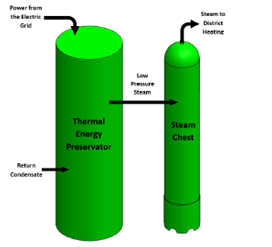Featured Galleries USUBC COLLECTION OF OVER 160 UKRAINE HISTORIC NEWS PHOTOGRAPHS 1918-1997
 Holodomor Posters
Holodomor Posters

Holtec Announces a New Hi-Heat District Heating
Technology that would end Society's Reliance
on Burning Gas
.jpg) Holtec Highlights, Holtec International
Holtec Highlights, Holtec International
Jupiter, FL, Mon, Jul 4, 2022
Jupiter, Florida..To mark the day that heralded the dawn of liberty and freedom in America, Holtec International today announces the HI-HEAT District Heater System that would end society’s reliance on burning gas, a notable contributor to environmental pollution, to heat homes and businesses around the world, especially the East European democracies desperately dependent on it during the winter months.
The capacity of the HI-HEAT district heating system is specified by a numerical annex which indicates the millions of BTU of thermal energy it stores to provide low pressure steam on demand.
Thus HI-HEAT 100 signifies a 100 million BTU (29.3 MWH) system that can deliver cycle steam at the desired rate of flow to a district heating grid. For example, if required to deliver 10,000 lbs. (or 4554 Kg/hour) of steam per hour to the district heating system, one HI-HEAT 100 system will exhaust its stored heat inventory in about 10 hours; or in 5 hours if the steam delivered is at double the rate, i.e., 20,000 lbs. (or 9108 Kg/hour per hour).
The HI-HEAT system is charged by the surplus power from the grid, i.e., when the available power exceeds the concomitant consumption. The source of electrical energy, preferably nuclear, solar or wind, may be hundreds of miles away from the district heater.
HI-HEAT 100 IS THE LARGEST PRACTICAL SYSTEM
HI-HEAT 100 is the largest practical system that can be shop manufactured and field installed. A smaller capacity HI-HEAT, say HI-HEAT 60 (60 million BTU or 17.6 MWH capacity) will be 60% of the height of HI-HEAT 100 but will be otherwise identical to it in anatomical details.
If adequately replenished with intermittent surplus electric power from the grid, the HI-HEAT systems can be sized to deliver heating steam continuously and indefinitely.
Because there is no limit on the number of systems that can be deployed in parallel at any site, there is no limit on the supply of steam available for district heating or any other application. As illustrated schematically on this page, the HI-HEAT system consists of two modules called the Preservator and the Steam Chest.
The Preservator is designed to preserve the stored heat losing only 8% after a month in the standby mode. The Steam Chest is a smaller insulated vessel which serves to maintain an inventory of steam to stabilize the supply system.
HI--HEAT SYSTEM HAS NO MOVING PARTS
The HI-HEAT system has no moving parts or life-limiting constituents and thus should be reasonably expected to serve satisfactorily for many, many decades. Unlike Lithium-ion batteries, the decommissioning of the HI-HEAT system will involve no disposal of hazardous materials.
In most cases, HI-HEAT 100 will simply retire and replace the existing gas boiler. Holtec expects to manufacture the HI-HEAT systems locally in the region where they will be used. 90% of the materials needed to build the system can be sourced locally. Having the HI-HEAT systems erected and commissioned during the coming winter in gas-shortage afflicted areas is feasible
“We think burning gas extracted from the land to pollute the environment is scandalous misuse of a natural resource that is best used to manufacture valuable industrial materials such as chemicals, plastics and the like.
"We envision the HI-HEAT district heating systems to be powered by the operating nuclear plants in the near term and by our SMR-160 advanced light water reactors in the next decade when we hope to begin commissioning our reactors in increasingly larger numbers to decarbonize the global environment,” says Holtec’s CEO and Chief Technology Officer (CTO), Dr. Kris Singh.
For more information, please contact: Erika Grandrimo | (856) 797-0900, ext. 3920 | e.grandrimo@holtec.com
NOTE: Holtec is a long-time member of the U.S.-Ukraine Business Council (USUBC), www.USUBC.org.











